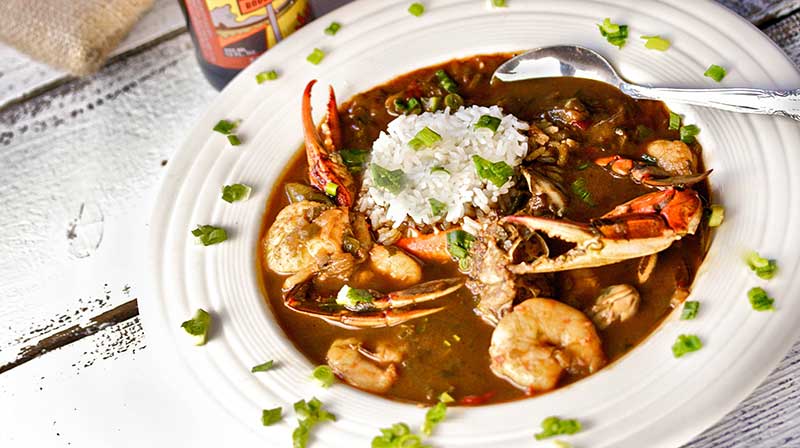What Is Gumbo Soup?
Gumbo soup is a flavorful and hearty dish that holds a prominent place in the culinary traditions of Louisiana, particularly in New Orleans. thelancasterfoodcompany will explore the origins, ingredients, preparation methods, popular types, serving suggestions, health benefits, common mistakes, and more about gumbo soup.
Origins and Cultural Significance
Gumbo soup originated in Louisiana, and it is deeply rooted in the rich cultural heritage of the region. Its creation can be attributed to the blending of various culinary influences, including African, French, Spanish, and Native American cuisines. This fusion resulted in a unique and delicious dish that has become an integral part of Louisiana’s culinary identity.
Ingredients
Gumbo soup typically consists of a flavorful broth, protein, vegetables, and a thickener. The main ingredients used in gumbo soup include:
- Protein: Common protein options for gumbo include chicken, sausage, shrimp, crab, and sometimes even game meats like alligator.
- Holy Trinity: A mixture of onions, bell peppers, and celery that serves as the base for many Louisiana dishes.
- Okra: A green vegetable that adds a distinct flavor and acts as a natural thickening agent.
- Roux: A cooked mixture of flour and fat (usually oil or butter) that adds richness and depth to the soup.
- Spices and Seasonings: Gumbo soup typically incorporates a combination of spices like paprika, cayenne pepper, thyme, and bay leaves.
It’s important to note that gumbo recipes can vary greatly based on regional preferences and personal taste.
Preparation
Gumbo soup is traditionally prepared by sautéing the holy trinity in the roux until it becomes aromatic and develops a deep brown color. The proteins are then added and cooked until they are partially done. Next, the broth and seasonings are incorporated, and the soup is simmered over low heat to allow the flavors to meld together. Okra is often added at this stage, along with any additional vegetables. The gumbo is cooked until the proteins are fully cooked and tender, and the flavors have developed.
To make a great gumbo, consider the following tips:
- Use a dark roux for a rich and robust flavor.
- Allow enough cooking time to let the flavors develop and the proteins become tender.
- Incorporate a variety of proteins for a more complex taste.
- Experiment with different seasonings and spices to customize the flavor profile of your gumbo.
- Adjust the thickness of the soup by controlling the amount of roux and okra used.
- Serve gumbo hot and allow it to simmer for some time before serving to enhance the flavors.
Popular Types
There are several popular types of gumbo soup, each with its own unique characteristics and flavors:
- New Orleans Gumbo: This is the most well-known type of gumbo, often referred to as “Creole gumbo.” It typically includes a combination of proteins such as chicken, sausage, and seafood like shrimp or crab.
- Creole Gumbo: Creole gumbo usually contains a variety of proteins and is characterized by the use of tomatoes in the recipe, which gives it a slightly tangy flavor.
- Cajun Gumbo: Cajun gumbo is a heartier and spicier version, often prepared without the addition of tomatoes. It commonly includes proteins like sausage, chicken, and sometimes game meats.
- Seafood Gumbo: As the name suggests, seafood gumbo focuses primarily on seafood, such as shrimp, crab, oysters, and fish. It’s a popular choice along the Gulf Coast.
Serving Suggestions
Gumbo soup is typically served over a bed of white rice, which helps absorb the flavorful broth. It is often accompanied by crusty French bread or cornbread. Some traditional side dishes that pair well with gumbo include coleslaw, potato salad, or a fresh green salad.
Gumbo is often prepared for special occasions and gatherings, such as Mardi Gras celebrations, family gatherings, and holiday meals. It brings people together and creates a warm and comforting atmosphere.

Health Benefits
Gumbo soup not only satisfies your taste buds but also offers some potential health benefits. Here are a few reasons why gumbo can be a nutritious addition to your diet:
- Nutritional Value: Gumbo soup is a good source of protein, vitamins, and minerals, depending on the ingredients used. It contains essential nutrients like iron, vitamin C, and potassium.
- Antioxidants: The combination of vegetables and spices in gumbo provides a variety of antioxidants, which can help protect your body against oxidative stress and reduce inflammation.
- Fiber: The inclusion of vegetables and okra in gumbo adds dietary fiber to your meal, aiding digestion and promoting a healthy gut.
However, it’s worth noting that the overall nutritional value of gumbo can vary based on the specific ingredients and preparation methods used.
Common Mistakes
While gumbo is a beloved dish, there are some common mistakes that can affect its taste and texture. Here are a few pitfalls to avoid:
- Burning the Roux: Achieving the perfect dark roux requires careful attention and stirring. Burning the roux can impart a bitter taste to the gumbo.
- Overcooking Proteins: It’s important to cook proteins until they are tender but avoid overcooking them, as this can result in tough and dry meat or seafood.
- Adding Okra Late: If using okra, ensure that it is added early in the cooking process, allowing it to simmer and release its thickening properties.
- Not Skimming the Fat: Skim off any excess fat that rises to the surface during the cooking process to avoid a greasy texture.
Conclusion
In conclusion, gumbo soup is a delightful and diverse dish with a rich history and cultural significance. Its origins in Louisiana have led to a variety of regional variations, each showcasing the unique flavors and ingredients of the area. By understanding the essential components and techniques involved, you can create a flavorful
and satisfying gumbo soup right in your own kitchen. Whether you prefer the classic New Orleans gumbo, the spicier Cajun version, or the seafood-infused variation, gumbo is a dish that brings people together and creates a sense of warmth and comfort.
Experiment with different proteins, seasonings, and spices to tailor your gumbo to your personal taste. Remember to pay attention to the roux, cooking proteins to perfection, and incorporating the right amount of okra for the desired thickness. Serve your gumbo over a bed of fluffy white rice and pair it with traditional side dishes like crusty bread or coleslaw for a complete and satisfying meal.
Frequently Asked Questions (FAQs)
What is the best protein option for gumbo?
Gumbo offers flexibility when it comes to protein choices. Some popular options include chicken, sausage, shrimp, crab, or a combination of these. Choose the proteins that you enjoy the most or experiment with different combinations for a unique flavor experience.
Can I make gumbo without roux?
While roux is a traditional and essential component of gumbo, there are variations that use alternative thickeners such as file powder (made from ground sassafras leaves) or okra. However, roux adds depth and richness to the dish, so it’s worth trying if possible.
Can I freeze gumbo soup?
Absolutely! Gumbo soup freezes well and can be stored in airtight containers for up to three months. When reheating, gently thaw in the refrigerator overnight and then warm it up on the stovetop over low heat, stirring occasionally.
How long does gumbo soup last in the fridge?
Properly stored, gumbo soup can last in the refrigerator for up to three to four days. Make sure to keep it in a sealed container to maintain freshness.
Is gumbo soup spicy?
The spiciness of gumbo can vary depending on personal preferences and the recipe you follow. Cajun gumbo tends to be spicier, while Creole gumbo may have a milder flavor profile. Adjust the amount of spices and seasonings to your desired level of heat.












